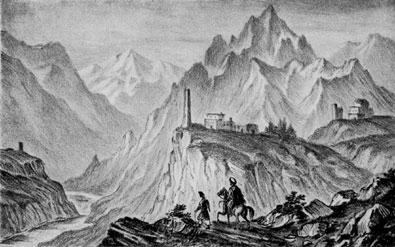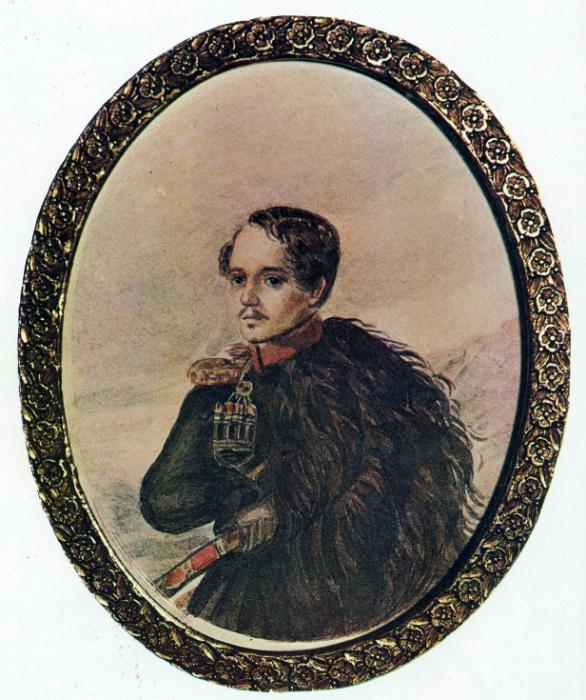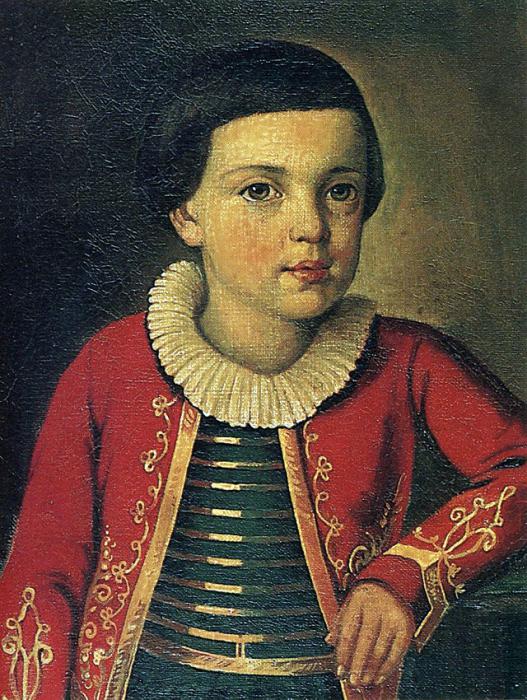Any painting made by the artist - whether it be an autumn landscape, a raging sea or a portrait of a young woman - bears the indelible features of the creator himself, his impression of the depicted object. In this sense, all painting is subjective and impressionistic. As for self-portraits, when they are created, the proportion of subjectivity is maximum. Unconsciously or intentionally, the painter transfers to the canvas what for strangers remains a secret behind seven seals. That is why self-portraits primarily attract the attention of art historians as a valuable artifact that has a complete resemblance to the original on the external (visual) and internal emotional planes.
Lermontov-landscape painter
The fact that Lermontov painted , not all know . According to the encyclopedia dedicated to the poet’s work, his love of drawing manifested itself from an early age. The image of Lermontov in the form of a boy of two years indicates that even then he was trying to draw something on scrolls. However, this gift was most fully manifested during the first exile to the Caucasus. Focusing on the Rembrandt system, Lermontov created canvases on the military theme, portraits and, of course, landscapes. The latter genre is most represented in the poet's pictorial heritage.

As you might guess, the wonderful nature of the Caucasus served as the material for the landscapes . Take, for example, the canvas “The Outskirts of Karaagach Village”. All the features of Lermontov’s artistic manner are noticeable in it, starting with a bright color and the specifics of the arrangement of the figures and ending with a special perception of nature displayed on the picture. The latter feature is elusive and appeals to intuitive rather than rational perception.
Lermontov portrait
Compared with sketches of nature, the portrait heritage of the poet has fewer works. Among them - a self-portrait of Lermontov in a cloak, images of Vera Lopukhina, S. A. Raevsky, A. I. Odoevsky, executed in watercolor (the list of paintings is incomplete). The poet also left several oil paintings and many sketches. Researchers note that many portraits are distinguished by psychological accuracy, as if heralding the beginning of a new direction in art - realism.
Life circumstances
Scientists date Lermontov’s self-portrait in 1837. The canvas was created during the first stay of the poet in the Caucasus, where he was sent for the poem "The Death of the Poet." M. Yu. Lermontov intended a self-portrait to Varvara Lopukhina, to whom he had tender feelings. The second cousin of the poet, Akim Pavlovich Shan-Girey, testified that the love affair for Lopukhina did not leave Lermontov until the end of his life.
The transfer of the canvas took place in June 1838 - before the departure of Barbara to Germany. Already from there, she sent Lermontov's self-portrait to A. M. Vereshchagina, who always encouraged any of his creative endeavors - pictorial, musical and poetic. On this, the story of the canvas breaks off: over the next 80 years it was considered lost irrevocably, so for a long time I had to focus on the copy that O. Kochetova made in 1880.
Description of the picture
Lermontov’s self-portrait of 1837 captures a young man dressed in the uniform of a Nizhny Novgorod regiment. A cloak is thrown over his shoulders, ghazyrs are placed on his chest, and in his hand the poet holds a saber. The Caucasus Mountains serve as a backdrop , which left a tangible mark in the memory of Mikhail Yurievich, despite the fact that Lermontov could only enjoy their appearance for several months.

On the back of the picture there is an inscription in German, which names the creator of the picture. Of course, Lermontov’s self portrait cannot be called ideal from the point of view of artistic performance. Art critics scrupulously seek out flaws in it like poorly drawn hands. However, is this important when we have before us an important document demonstrating what Lermontov experienced at that time? An innocent, kind, somewhat childish face with a sullen, sad, even tragic expression in his eyes is a kind of lyric diary of the poet. And the inscription intended for the beloved woman now looks like a contrast, in comparison with the banal museum: "Lermontov" Self-portrait "(watercolor, 1837)."
Further history of the canvas
The twentieth century has dotted all the i in the history of the poet’s self-portrait. Finally, a longed-for canvas was found: in 1955, it was acquired by German professor Winkler. Lermontov’s self-portrait began to change hands, until 7 years after his discovery, he fell from the then Federal Republic of Germany to his homeland, to the great joy of fans of his work.
The poet on the canvases of various artists
Of course, Lermontov’s self-portrait, the description of which was presented above, is far from the only image of the poet. The earliest painting depicting Mikhail Yuryevich is considered to be a drawing by an unknown artist, possibly a serf, who transferred the outlines of a four-year-old child onto paper. The second portrait also captures the poet as a child. The author of the canvas depicted a smartly dressed boy with combed hair. Some art historians question the authenticity of the picture, however, its similarity with the first image of Lermontov and the poet’s brother’s memories indicate just the opposite.

There are no pictures in which Lermontov would have been captured during his studies in Moscow. Only in 1834, when he was transferred to cornets, did her grandmother order a portrait of her grandson. There is a desire of the artist to somewhat embellish the appearance of the poet. At the same time, the portrait is credible not only due to its good external resemblance to the original, but also by Lermontov’s correctly noticed mood and expression of his eyes.
The image of the poet made by his painting teacher Zabolotsky became widely known. The artist was not a great master, however, the completed portrait testifies to a good knowledge of Lermontov’s nature. The same can be said of other images of the poet, which perfectly complement our idea of him.